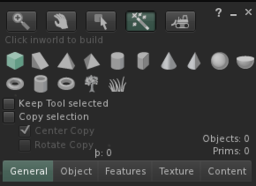Good Building Practices
This guide is a collection of officially verified building practices for moderate to advanced creators that result in efficient, high performance creations in Second Life. If you are new to building in Second Life, please check out the Knowledge Base.
Featured Article
|
News & UpdatesThis portal is undergoing renovation
| |||
First stepsTopics for new builders who want to learn how to create content in Second Life. Many of these articles can be found in the Second Life Knowledge Base, a collection of articles aimed at new Residents:
Animation
Tips on how to animate your avatar and other objects.
Mesh
Complex objects can be modeled using third-party 3D modeling software and then uploaded to Second Life. These objects require special logistical considerations to manage the amount of land impact they consume.
|
Pathfinding
Pathfinding allows scripted objects to intelligently move from one place to another while avoiding obstacles.
Physics
Use these tips to find a balance between physics accuracy and performance in order to minimize the amount of land impact generated by your objects.
Sound
Tips on how to best use sounds in your creations.
|
Scripting
Linden Scripting Language allows you to program your objects with interactive, scripted behaviors.
Textures
Tips on using textures in Second Life, including the use of specular and normal mapping to give a tactile 3D look to your objects.
| ||
Resident contributions awaiting official approval
If you'd like to contribute some of your own best practices for efficient content creation, please link to them in this section so that Linden Lab subject matter experts can verify them before they are added to the official guide.
